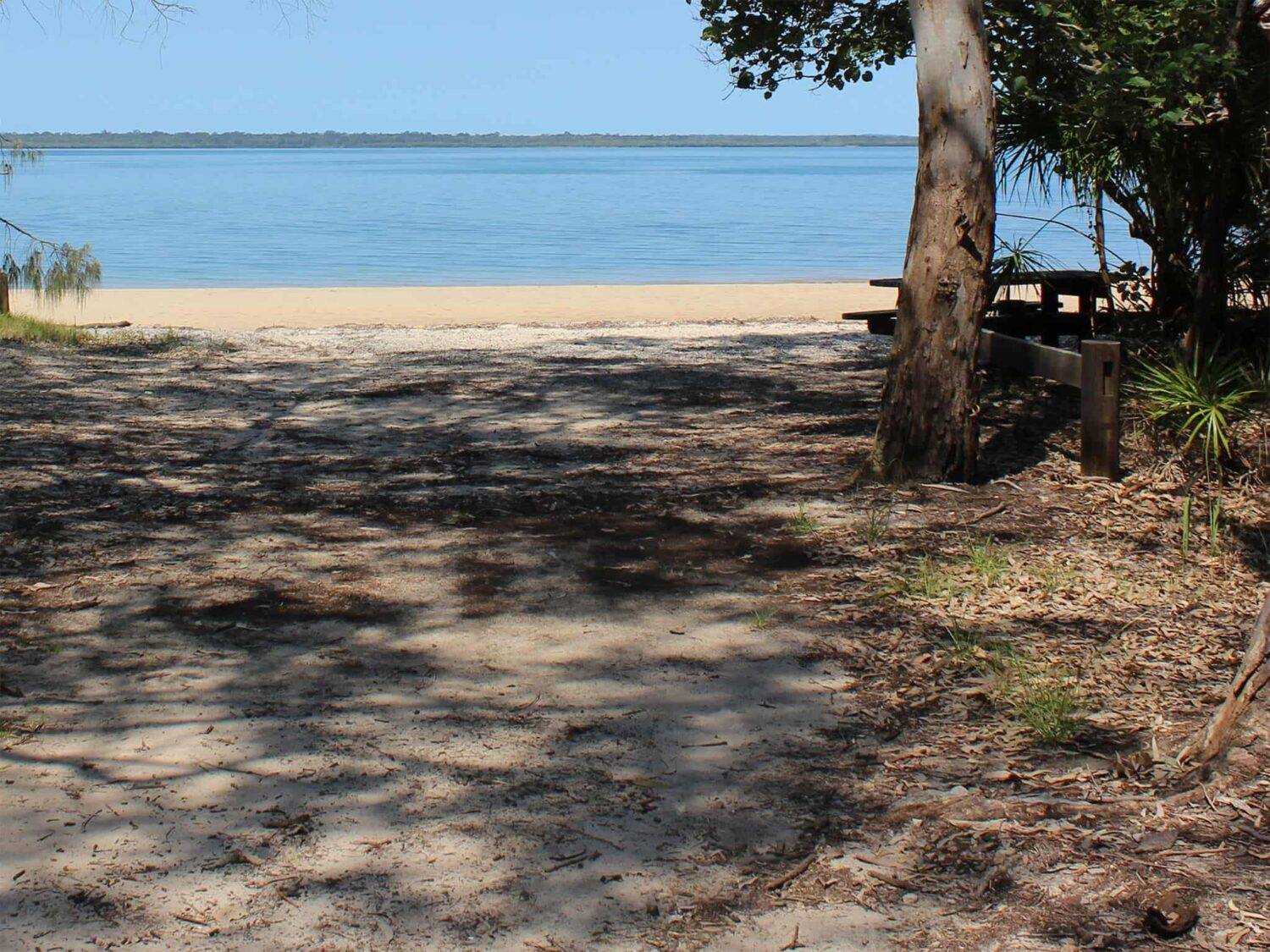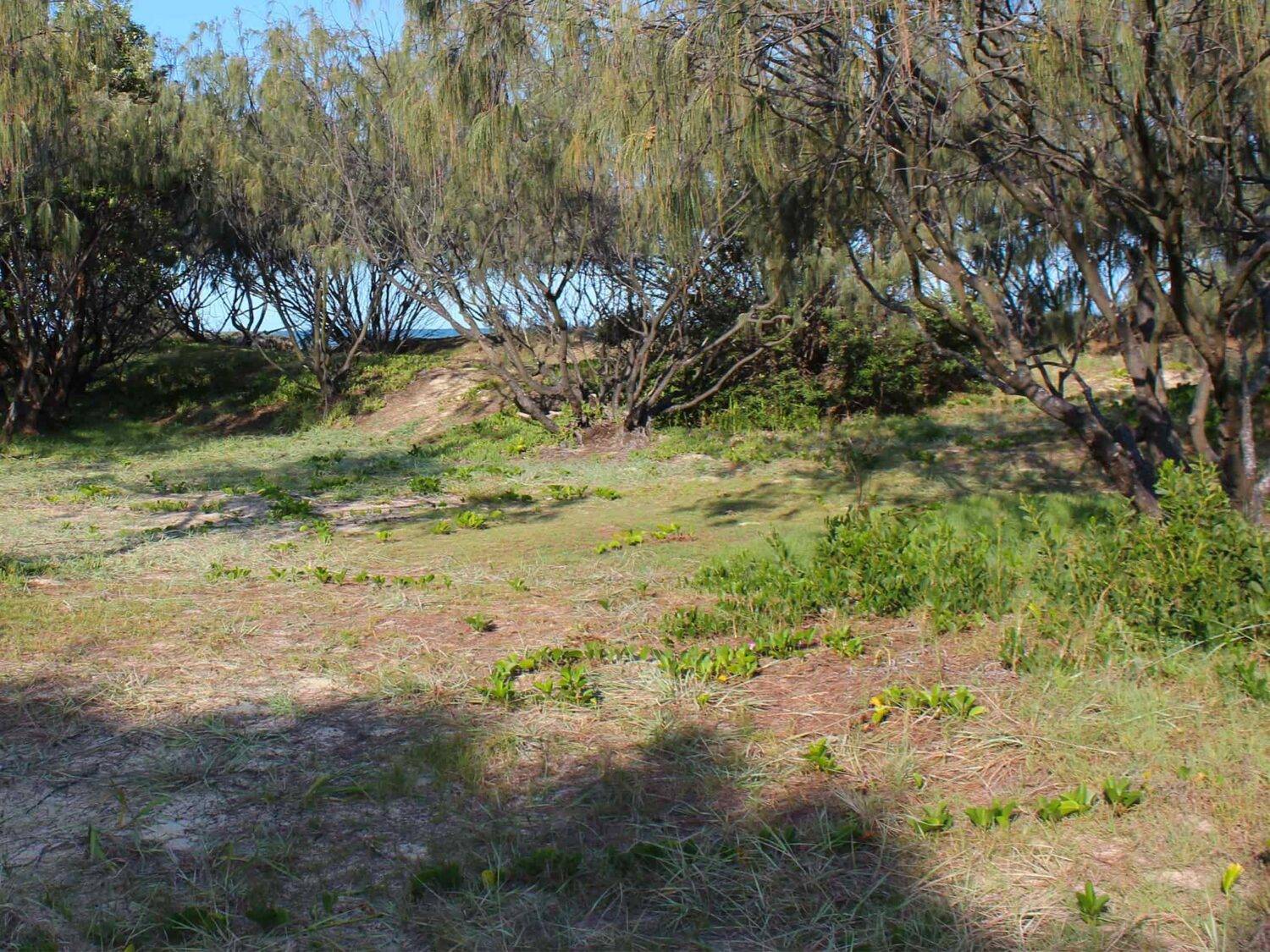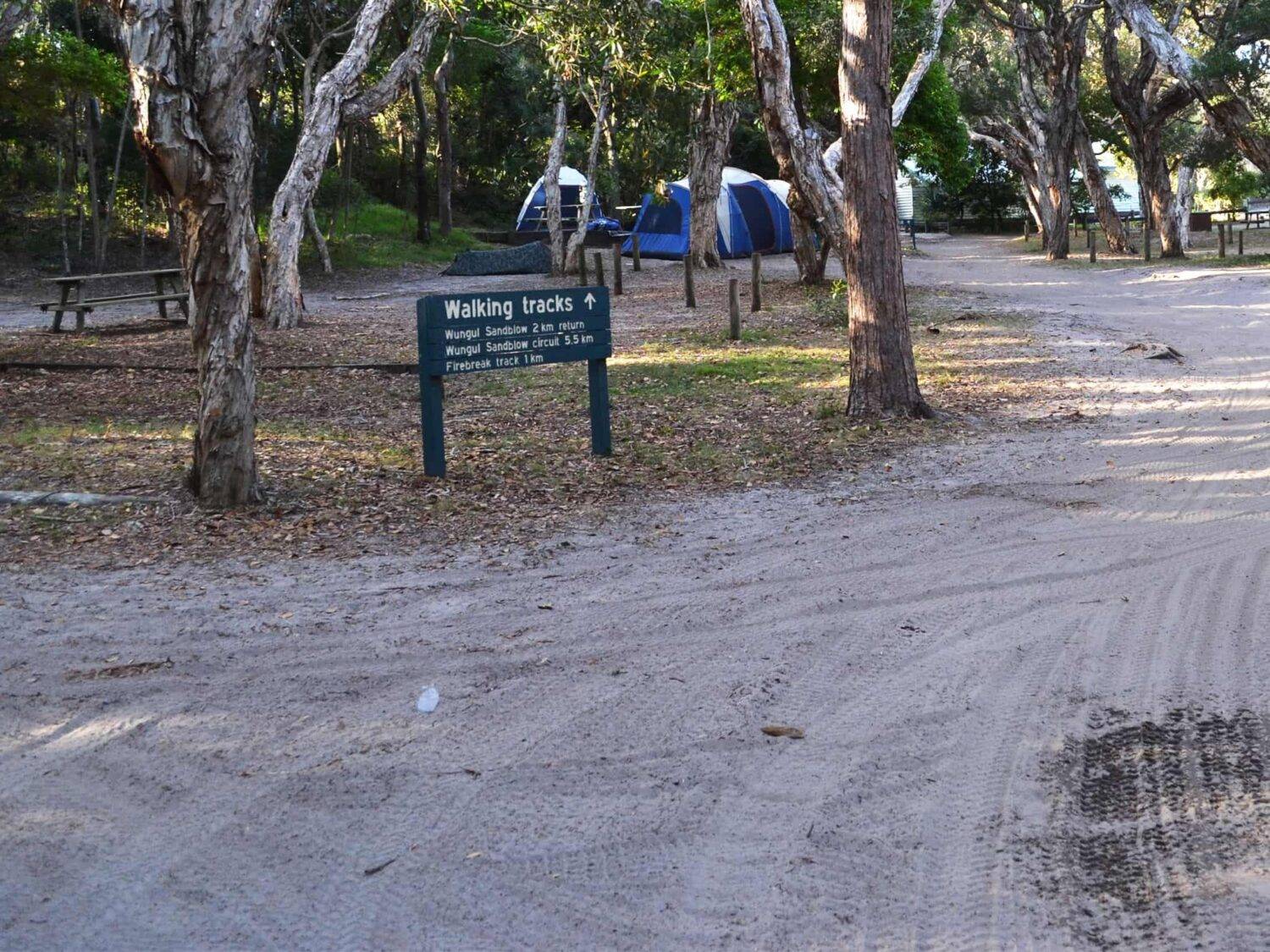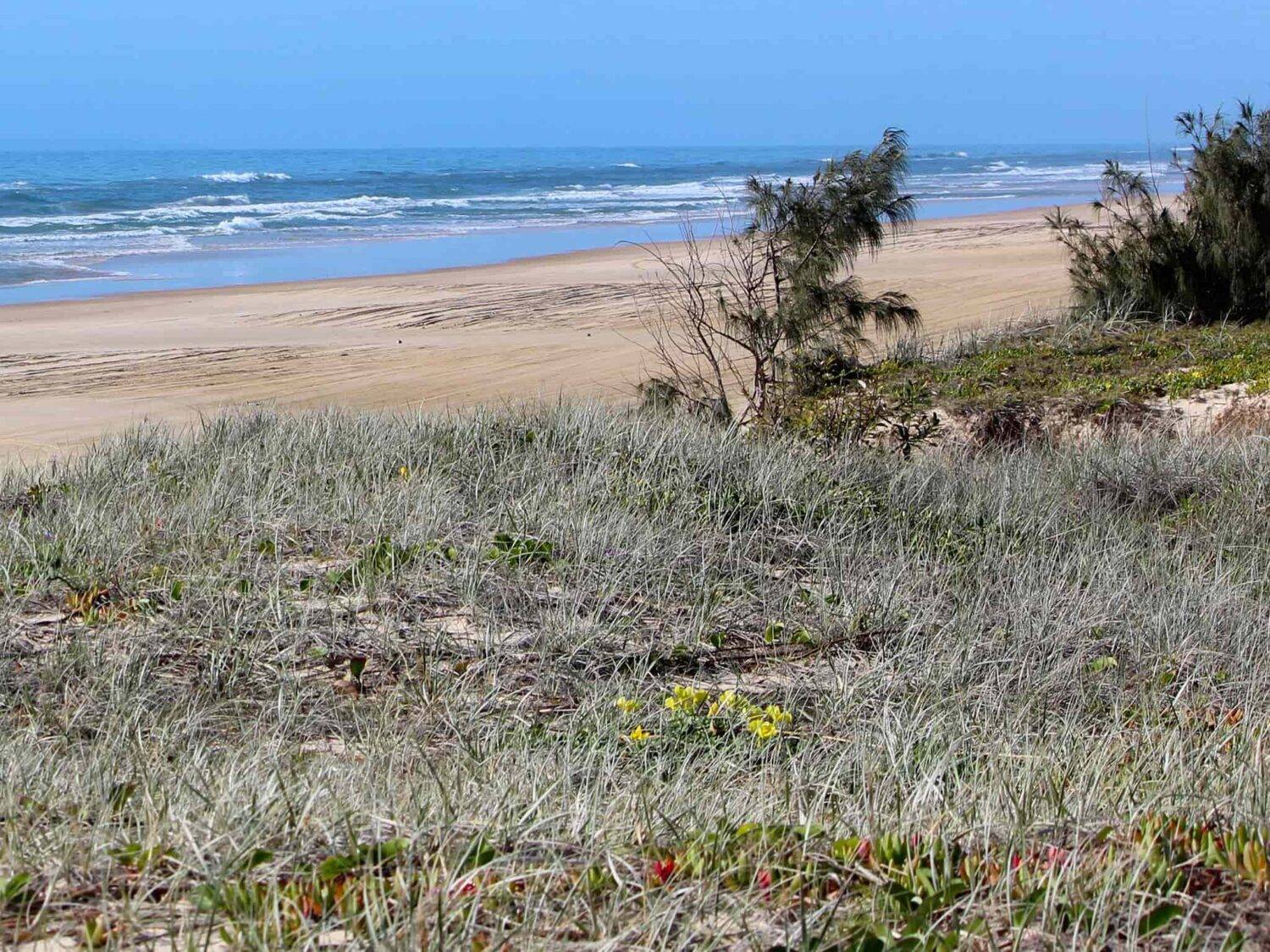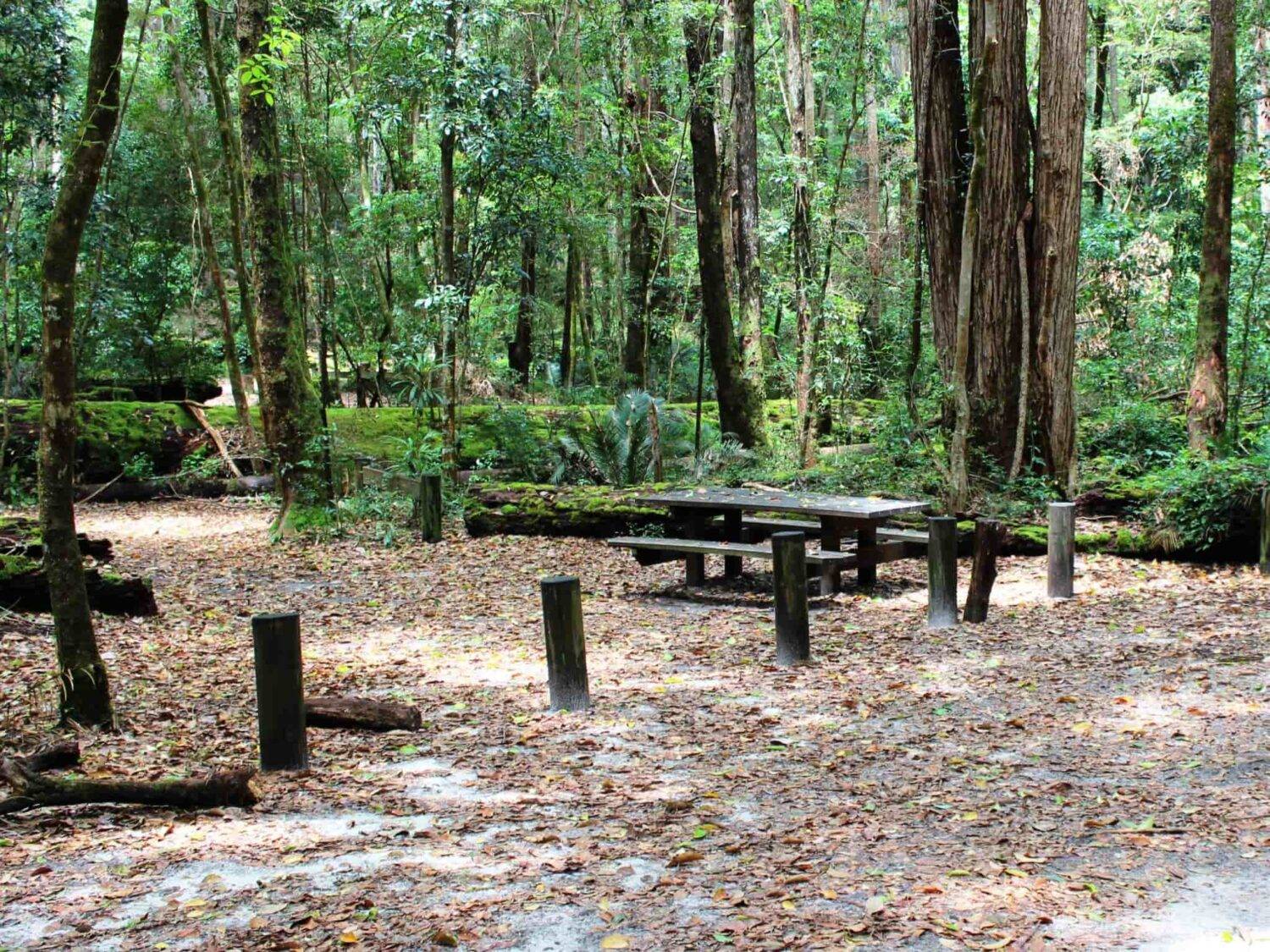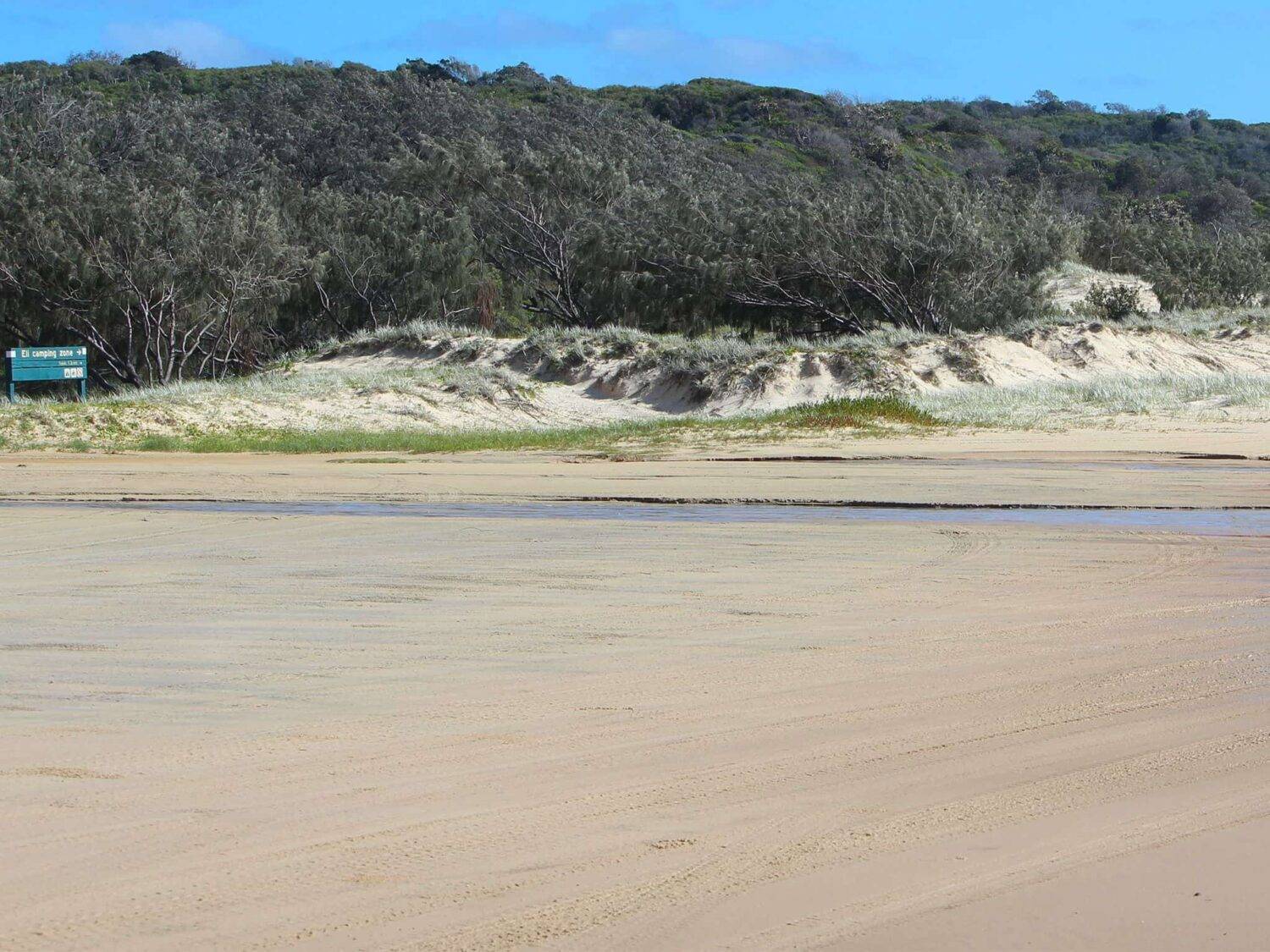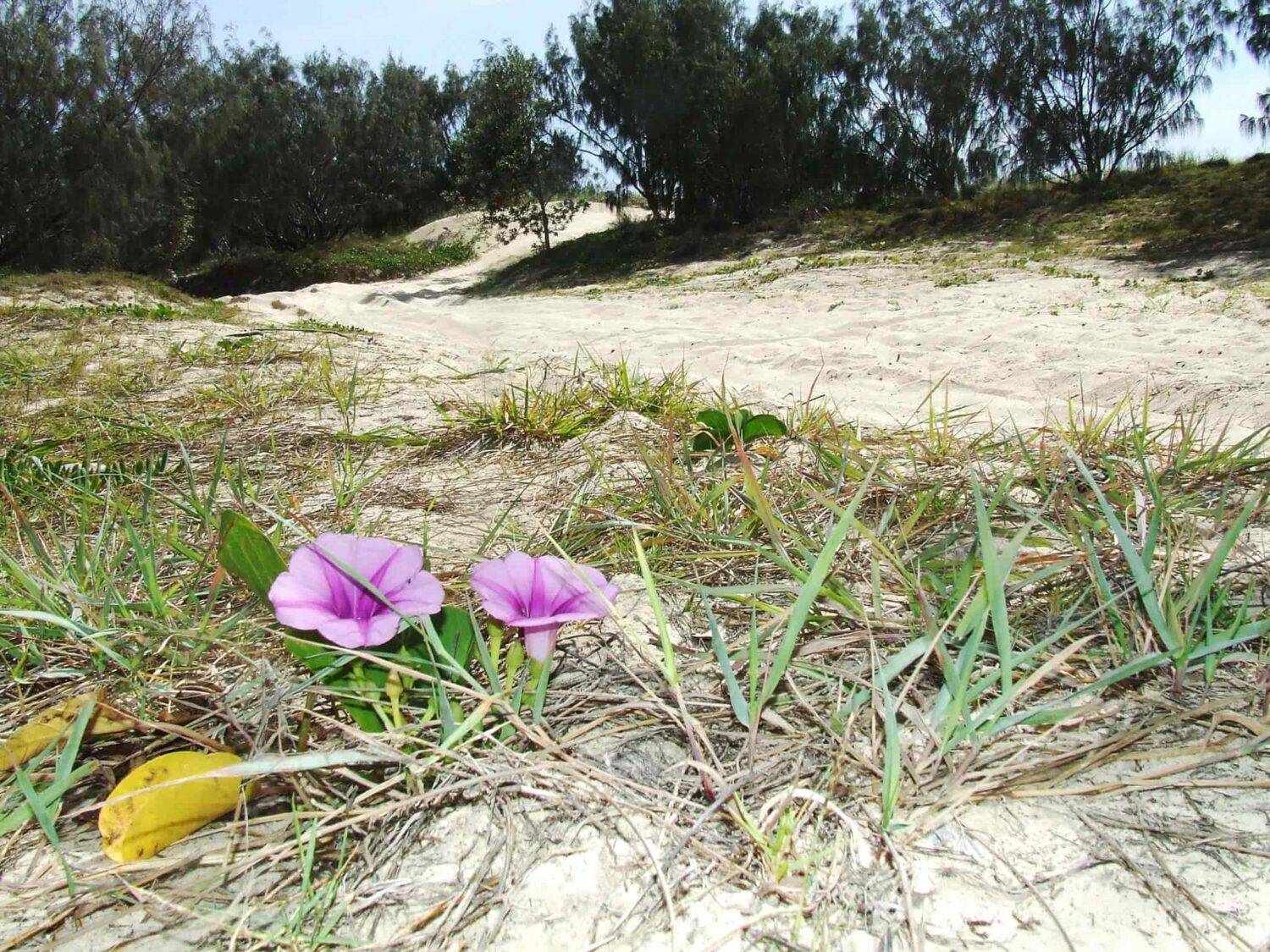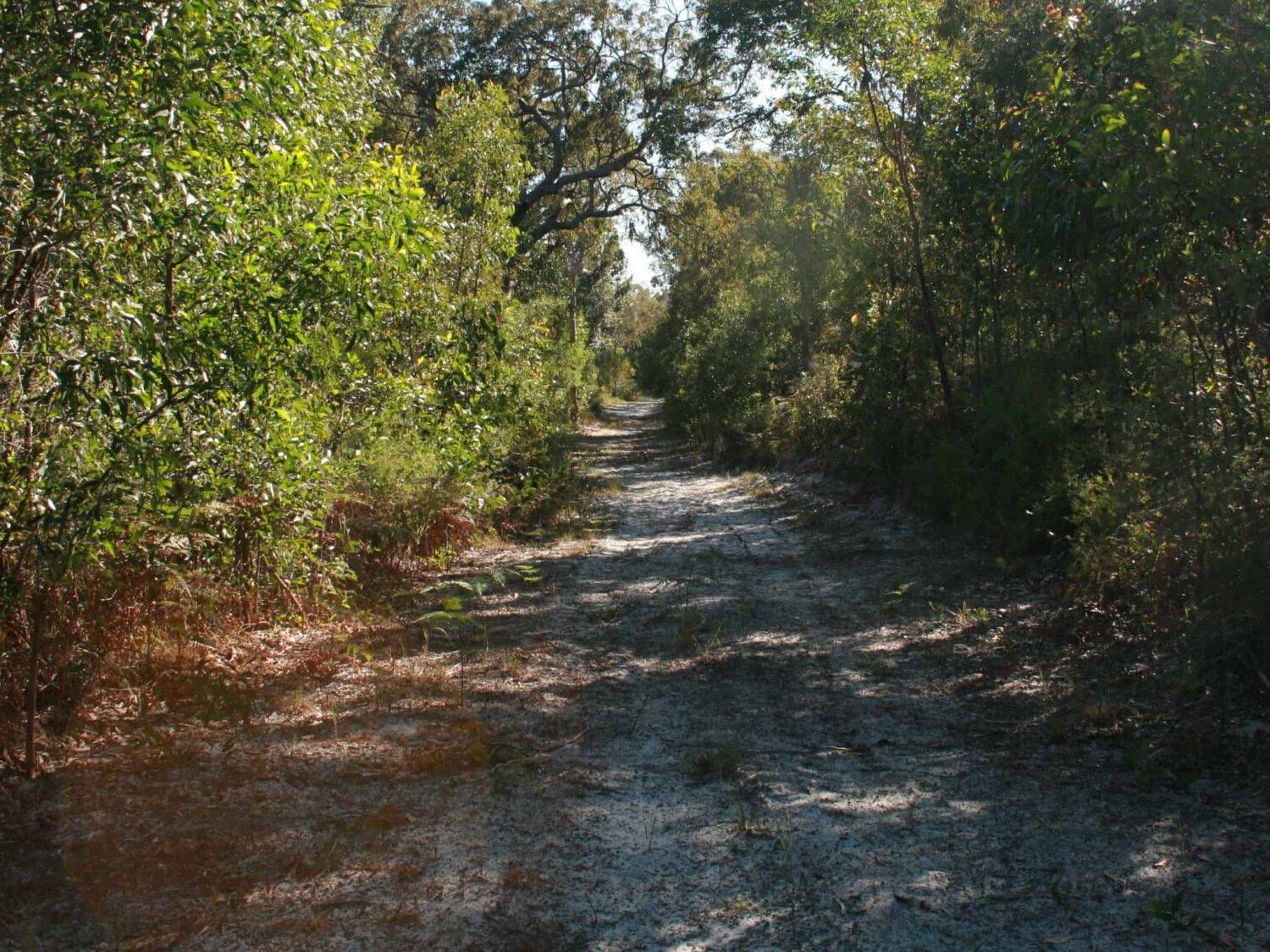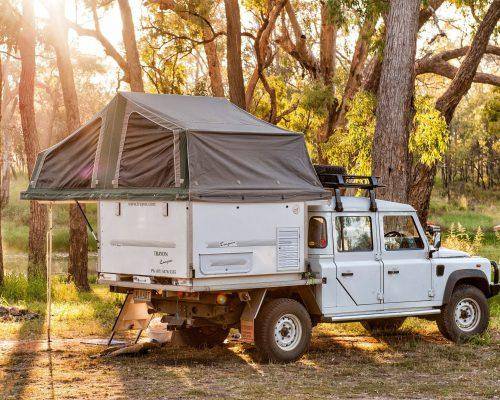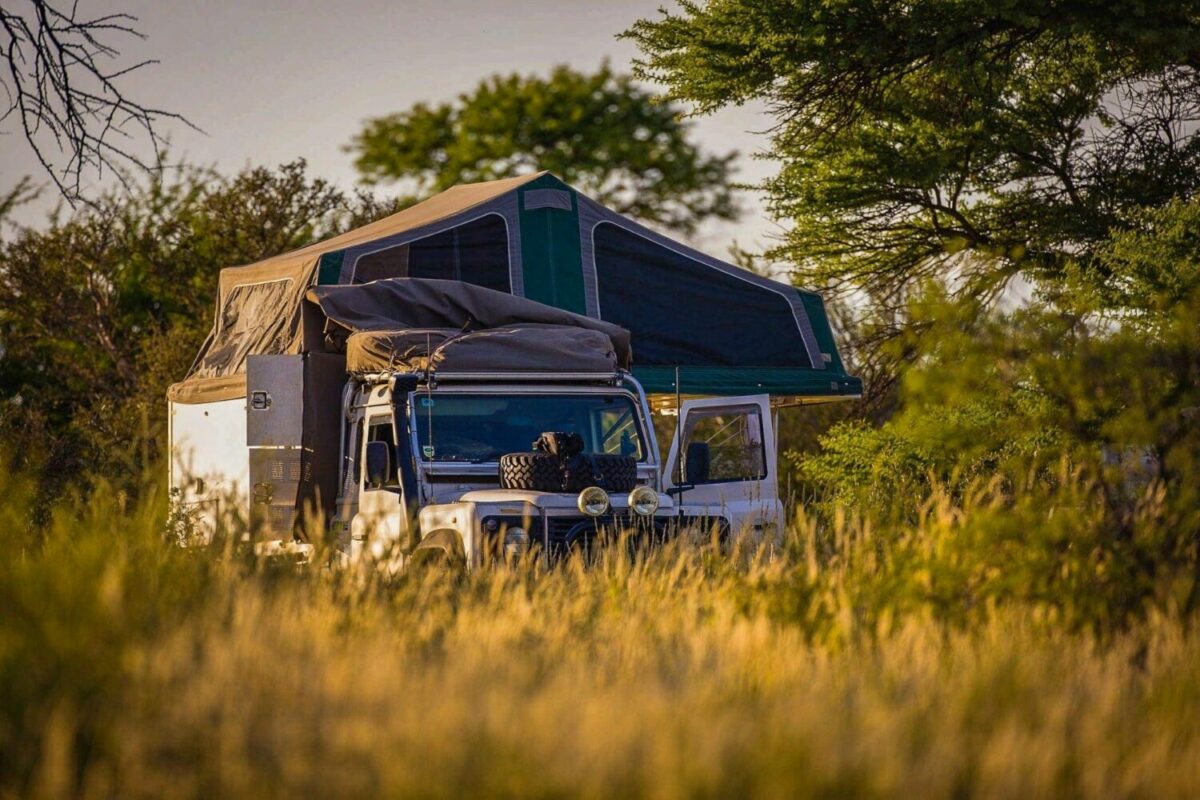
K’gari (Fraser Island) camping is one of the most incredible experiences in Queensland, Australia. We love loading up our 4WD’s and camping on Fraser Island, so we created this guide for what to expect, what you’ll need, and how to prepare for camping on this great rugged sand island.
With sand dunes taller than the Sydney Opera House and over 100 freshwater lakes, Fraser Island is where your next camping holiday should take place.
We’ve done the heavy lifting here so sit back and relax because here is everything you’ll need to know so you can get your 4×4 packed and fueled up for your camping adventure.
Your trip begins well before you leave the mainland.
From what to pack to the ferry timings to local things to do. This article will cover it all and hopefully, leave you more informed than before you started.
FRASER ISLAND TRAVEL GUIDELINES
Queensland Government’s Roadmap for easing COVID-19 restrictions
We recommend checking the latest government updates prior to travel.
Your Fraser Island Camping Journey Begins Here
Using all of our experience and resources we’ve compiled a list of the best (in our opinion) camping areas, considerations once you arrive, and safety measures during your camping on Fraser Island.
So let’s begin planning your next adventure and let the excitement start building.
*Note: All information herein is subject to change and current as of 14AUG21. Check the Queensland National Parks Website for the most current information
Dingoes on Fraser Island
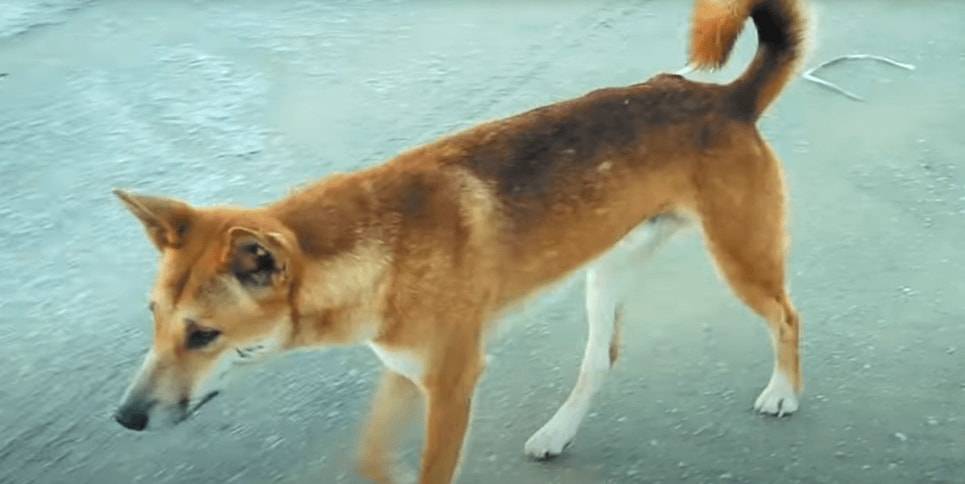
There is a healthy protected dingo population Fraser Island, this is one of the reason domestic pets are not allowed. Some campsites are dingo free zones if you have concerns about bringing the kids. Make sure under no circumstances you feed the Dingoes. They are not shy.
Things to do before you go
There are two types of permits required to go camping at Fraser Island in your 4WD. They are:
- Vehicle Access Permit
- Camping Permit
Vehicle Access Permit Pricing
Vehicle access permits are mandatory before driving onto the ferry en route to Fraser Island. All vehicles must be registered and have a valid permit. You must clearly display the details of your permit on your vehicle for inspection by authorised officers.
There are two types of Permits, one specifically for Fraser Island, and the other of the Cooloola Recreation Area. This is the area south of K’gari (Fraser Island) like Noosa North Shore up to Rainbow Beach, with plenty of beach driving.
So if the weather is good you might want to drive up along the beach through the Cooloola Recreation Area.
K’gari (Fraser Island) Recreation Area
- 1 month or less = $54.55
- More than 1 month (up to 1 year) = $274.50
K’gari (Fraser Island) and Cooloola Recreation Area
- 1 month or less = $87.60
- More than 1 month (up to 1 year) = $439.60
*Notes: Pricing subject to change
Camping Permits
When booking a campsite you must take several things into account: The peak periods, the popularity of a particular site, weather, and of course camping permits.
Queensland national parks booking site makes it fairly simple to reserve your favourite campsite.
All factors considered, the number one precaution is that of availability. Fraser Island camping areas can be especially busy during the Summer Season (September through April). So be sure to book your camping permit at least six weeks out from your desired date if you are planning a Summer Camping trip.
Local Tip: They limit the numbers of campers & vehicles in peak times of the year like school holidays & public holidays. New years is perhaps the busiest time for both Cooloola Recreation Area & Fraser Island.
In some parks and forests, you can book up to 12 months in advance.
Camping fees
Camping as a family is what makes a lifetime of memories and you can save a bit of money while you’re at it by purchasing a family rate camping permit. If you’re solo and doing the Fraser Island Great Walk it might be a bit more expensive.
General Admission
- $6.85 per person per night, or $27.40 per family per night
- $3.75 per person per night for students and accompanying adults on approved educational excursions
Family rate
A family group camping permit is defined as one or two adults and accompanying children under 18, up to a total of eight people. Children under five years of age camp for free at all camping areas.
Special Group Rates
Special group rates are available for Group Accounts, Educational Accounts, and Commercial Operator Accounts. You can apply here.
Fire Permits
Are not available. Fires are only allowed in designated communal fire rings located at specific camping areas:
- Dundubara main and Dundubara group camping areas, and Waddy Point camping areas have communal fire rings (top and beachfront).
Also keep your eye on any fire bans in the area due to dry weather.
Pet Permits
Domestic pets are not allowed in the Great Sandy National Park.
The only exception to this rule is that of a special assistance pet such as a seeing-eye dog or other approved animal. Permits for such animals must be obtained prior to arrival at Fraser Island.
How to get there
Ferry locations & timings
To get you & your family / mates over to the island, you’ll need to hitch a ride on one of the Vehicle ferries that make the crossing regularly.
Here are the Ferry options:
The Fraser Venture
If you are coming from North of Fraser Island, then perhaps the best Ferry to catch is the Fraser Venture which departs River Heads daily landing at Wanggoolba Creek just 20 mins south of Hervey Bay. Crossing time is approx. 30 minutes.
Wanggoolba entry point is on the West Coast. The west coast doesn’t have as many campgrounds, but it can be more protected with a smaller ocean swell.
Depending on the sand tracks it can take approx. 45 mins to cross to Eurong Beach Resort on the east coast by 4WD.
Departure timings:
- Departing River Heads: 8:30AM and 3:00PM
- Departing Wanggoolba Creek: 10:00AM and 4:00PM
*Pricing subject to change. Be sure to check availability on their website.
Manta Ray Barges
(contact 07 5486 3935)
Departing from Inskip Point, The Manta Ray Barges service operates 2 barges daily. Online booking is no longer an option but have no fear because a barge is available every 30 minutes and tickets can be purchased on board. Trip duration 10 minutes.
Departure timings:
- Every 30 minutes from 6:00AM – 5:15PM
- The last barge to Fraser Island runs at 5:00PM
- The last barge leaving Fraser Island is at 5:15PM
Note: Pricing of the barge varies depending on the vehicle type and if you are towing anything. Pre-booking via phone a few days before is the best option.
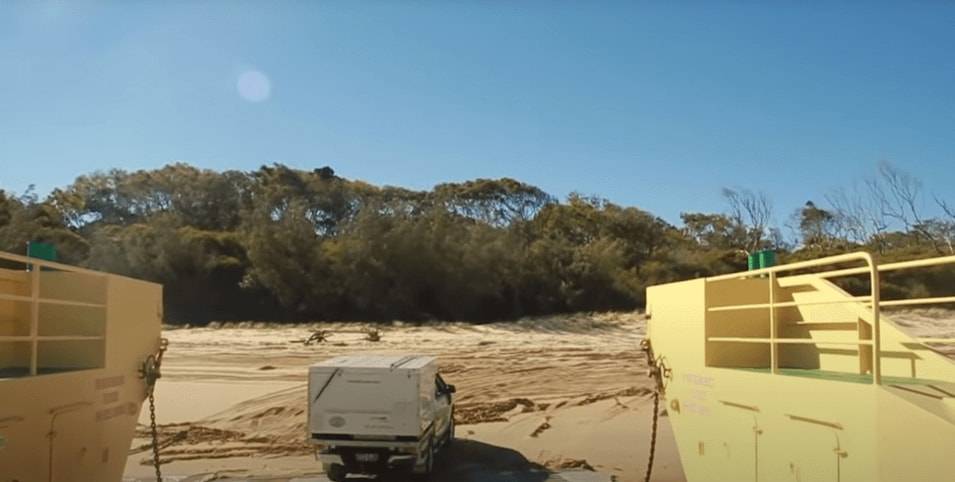
Don’t let the weather ruin your plans
Depending on the time of year you could be experiencing a drastic change in temperature. Due to the subtropical environment, storms can become an issue quite quickly as well and make it hard to reach your camping areas.
The Fraser Island winter months from May to August can produce temperatures between 14-25° celsius. being the driest time of year it’s a slim-to-none chance that you’ll experience rain.
From September through the end of April temperatures will linger in the 30°s, the summer season could possibly bring rain and occasional ferry delays as well. Most camping spots are open to the elements.
For a more in-depth and daily update be sure to visit your favourite weather site. These are a few of ours:
| Saturday | +21° | +17° | |
| Sunday | +21° | +19° | |
| Monday | +22° | +21° | |
| Tuesday | +23° | +19° | |
| Wednesday | +20° | +16° | |
| Thursday | +20° | +16° |
What to Bring
Packing the essentials can be a daunting task but it doesn’t have to be.
The things we bring end up consuming all our time setting up & packing up might weigh us down is the soft sand, so our vehicle is not so nimble over soft sand en route to our camping areas.
So we’ve broken it down into a simple checklist.
Humans
The duration, time of year, and location will all play a factor in the human category of packing camping gear. This is a starting point, feel free to add to it as necessary.
- Clothing
- Long pants (at least 1 pair)
- Short pants (at least 1 pair)
- Swimming trunks (at least 1 pair)
- T-shirts (1 more than the trip duration i.e. 1 day 2 shirts)
- Long sleeve shirt (at least 1)
- Socks & Underwear (2 more than the trip duration i.e. 1 day 2 sets)
- Headgear (hats, beanies in winter)
- Enclosed Footware (Hot Sand / 4WD recovery)
- Sandles or Equivilant
- Gear
- Headlamp + batteries
- Gloves (1 pair)
- Fishing pole & Lures
- Rope
- Hatchet or axe
- Rags or paper towels
- Eating utensils
- Plates
- Cups
- Toiletries
- Toothbrush/Paste
- Soap (universal shampoo/body wash)
- Toilet paper
- Drying towel
Vehicle
If you decide to drive your own rig onto the island, this packing list is also a checklist of things to do before you hit the road and sand.
- Maintenance
- Check engine oil
- Check transmission fluid
- Check drivetrain
- Check tire serviceability
- Inspect engine bay for issues
- General vehicle operations
- Recovery Gear
- Recovery Strap
- Appropriate D-Shackles
- Winch serviceability
- Shovel
- Traction boards (Maxtrax or Similar)
- Jack
- Tire removal tools
- Snatch block
- Tire saver straps
- Air compressor (optional)
- Tire pressure gauge
- Interior
- Seats or seat covers
- Heating and aircon
- 12v power sources
- Cargo organisation of some kind
- Fridge / Esky for Food & Drinks
Your home away from home
With all the packing going on don’t forget about campsite essentials. Remember even though there’s a lot of awesome gear out there, doesn’t mean it all has to come with you (we’re guilty of this too).
Too much gear & you can quickly have a miserable time. Especially if it’s a short trip over a long weekend.
Packing for the campsite
- Chairs
- Mattress of some kind
- Sleeping bags or blankets
- Pillows
- Bug repellant
- Radio or BT Speaker
- Cooking stove
- Shelter of some kind (Tent, Slide on Camper, Camper Trailer etc.)
Food & Water
Whether you have children, a significant other, or travelling solo all determines what you’ll bring to fill your belly while beach camping.
Each and every one of us has our go-to camping meals. A favourite BBQ dish or must-have fruit for snacking.
We won’t try to guess your favourite foods but please ensure you bring plenty of water for the duration of your trip to Fraser Island, because it can get very warm and Fresh water access is limited.
Island Bottle Shops and Groceries
We suggest you pre-plan and shop on the mainland for one simple reason: cost. While most shops on the island can and will accommodate your needs, it comes with a hefty price tag and limited choice. So make sure you pack your food & drink supplies before you leave the mainland. There is a grocery store a Hervey Bay if your coming from the West, and one a Tewantin if you are coming from the south.
But if you do crave something last minute or just want to splurge on your holiday! Here is a list of Fraser Island shops:
Eurong Beach Resort
At Eurong Beach Resort you can buy snacks or souvenirs from the shop, enjoy a fresh coffee or a dessert from the bakery. Open seven days a week.
Happy Valley General Store
Happy Valley General Store has a decent selection of groceries and a cup of coffee sitting at the provided picnic tables to start your day.
Cathedrals on Fraser Shop
Cathedrals on Fraser campsite shop has all the essentials to resupply your adventure on the Eastern Beach.
Kingfisher Bay Resort, General Stores
Kingfisher Bay Resort has all that and a bag of chips! Sausage rolls, bakery selections, sandwiches. You can even buy souvenirs.
Orchid Beach Trading Post
Orchid Beach Trading Post has basics and a bit more depending on what you’re needing.
Things to do on Fraser Island
While enjoying the peace and tranquillity of beach camping, you might also want to take part in some of these exciting attractions and sights to see.
Snorkeling & Swimming on Fraser Island
Swimming & Snorkeling in the ocean surrounding Fraser Island is prohibited. This is because with 100’s of kms of unpatrolled beach, some pretty extreme undercurrents & rips and a very healthy shark population, it’s difficult for emergency services to get to you in time.
This is a pretty remote, rugged location, better to be safe than sorry.
There are some supervised boat tours you can do which include snorkeling as an activity.
You Can Swim in Some Locations
You can swim in some of the inland lakes (listed below), and the kids might like to put on the goggles and explore a little bit, however, the inland lakes are spectacular and refreshing to swim in, yet pretty empty and dark under the water (speaking from experience, because I was curious).
Kayaking & Canoeing
Kayaking & Canoeing is only available with guided tours either from the mainland or Kingfisher Bay resort on the west coast.
Eli Creek Oasis
Bring a tube to float for maximum relaxation. The boardwalk provided by Queensland Parks is a sure path to the beginning of the walk. You can also find Lake Boomanjin near this location. Rest and have lunch at one of the nearby picnic tables before you return to camping on Fraser Island.
Note: The parking at Eli creek can become like a shopping car park in the peak season, only on soft sand. If you are towing a trailer, perhaps setup camp first then come back to this as the Trailer can quickly get you bogged in the soft sand.
Visiting Hammerstone Sandblow
The largest sand dunes on the Island will leave you feeling as if you’re in the Arabian desert. Darting out of the rainforest and surrounding Lake Wabby, it seems to stretch to the horizon and its natural beauty is a sight to see.
Explore by 4WD
There is so much to see on Fraser island, getting about is only possible by 4WD.

Champagne Pools Natural Ocean Lake
Between Indian Head and Waddy Point, you’ll find these naturally occurring pools along 75-mile beach. Watch out for the big waves that occasionally breach into the calm waters of the East Coast Champagne Pools on this.
Wanggoolba Creek Rainforest Walk
Escaping the East Coast into the middle of rainforest you’ll find a Butchulla Sacred birthing site. Crystal clear waters are surrounded by a living breathing ecosystem.
Lake McKenzie
Perhaps the most popular lake for Swimming is Lake McKenzie. It’s interesting because this lake was formed from pure rain water, no other rivers flow into it. It’s a really refreshing place to swim, on a sunny day it’s blue water will draw you in.
It’s accessible only by high clearance 4WD with low range ability through Lake McKenzie Rd.
Fraser Island Camping Locations
*Listed in order from South to North if travelling from Inskip Point. GPS coordinates are not exact locations
Coolooloi Creek Camping Area
At Coolooloi Creek Camping Area you’ll find a gorgeous bush camping remote location with plenty of shade trees but minimal amenities.
Very popular camping area due to its proximity to the ferry drop-off point.
Booking as far in advance as possible is recommended. Tent, camper and trailer sites available.
Distance Inskip Point approximately 7km / 30 minutes
Coolooloi Creek Camping Area Facilities:
- Generators (Conditions apply)
- Tent camping
- Walking
- Boating
- Picnic Tables
- Anchoring allowed
- Short walk to beach
- Scenic driving
- Ocean fishing
- Canoeing and kayaking
- No permanent tents
- Bring own toilet
- Camper trailer camping
Govi and Wongai Camping Areas
A short drive from Hook Point Landing you’ll find Govi & Wongai camping areas.
The southern camping zone is tucked into the coastal greenery for that connection to nature you’re searching for. Tent, camper and trailer sites available.
Of all the beach camping zones, this beachfront camping area is one of our favourites.
The camping area is usually only accessible for 2 hours on either side of low tide.
Although you can take a trailer to these campsites, we recommend that they are better suited to for roof top camps, tent camps and slide on campers like the Trayon Camper.
The main reason is because some of the cuttings into the campsites over the dunes when dry are very challenging to cross with two axles let alone three.
Govi And Wongai Available Facilities:
- Generators (Conditions apply)
- Tent camping
- Walking
- Short walk to beach
- Scenic driving
- Ocean fishing
- No dingo deterrent fences
- No permanent tents
- Bring own toilet
- Camper trailer camping
Dundubara Camping area
Clean roads and designated campsites.
This camping zone is free of debris and well maintained.
Family-friendly with picnic benches and rubbish bins provided by Queensland Parks.
Distance from Rainbow Beach or Inskip Point is approximately 7km / 30 minutes
Dundubara Campsite Available Facilities:
- Telephones (pay phones)
- Campfires allowed
- Tent sites camping
- Fishing
- Picnic Tables
- Waste transfer station
- Flush toilets
- Scenic driving
- Wheelchair access
- Paid hot showers
- Dingo Fence
- Camper trailer camping
One Tree Cornwells Gabala Camping Area
High clearance 4-wheel drive access area stretching from Eurong to Poyungan Rocks.
The camping area is also near Central and Southern Lakes scenic drives.
Lake Mckenzie is a bit inland but well worth the drive.
Booking ahead of time to secure your slice of the beach.
The camping zone is on the eastern side of the island between Eurong and Poyungan Rocks. Eurong is 35.5km north of Hook Point.
One Tree Cornwells Gabala Available Facilities:
- Generators (Conditions apply)
- Tent camping beside car
- Walking
- Short walk to beach
- Scenic driving
- Ocean fishing
- No Dingo Fence
- Camper trailers camping
Central Station Camping Area
44 walk-in tents sites and 16 camp trailer sites surrounded by greenery.
A dingo free area so you can relax as the children play freely while camping on Fraser Island.
The holiday season is extremely busy for this valley camping zone.
Central Station is close to Lake McKenzie and Lake Boomanjin for those nature walks.
Central Station Camping Area Available Facilities:
- Wheelchair access
- Tent camping beside car
- Tent sites camping
- Walking
- Paid showers
- Picnic tables
- Scenic driving
- Flush toilets
- Dingo Fence
- Pay telephones
- Camper trailers camping
Happy Valley Camp Zone
Centrally located camp zone sitting directly in the middle of 75 Mile Beach.
Surrounded by incredible sea views, yet nearby restaurants grace the local township. Home of the Maheno Shipwreck.
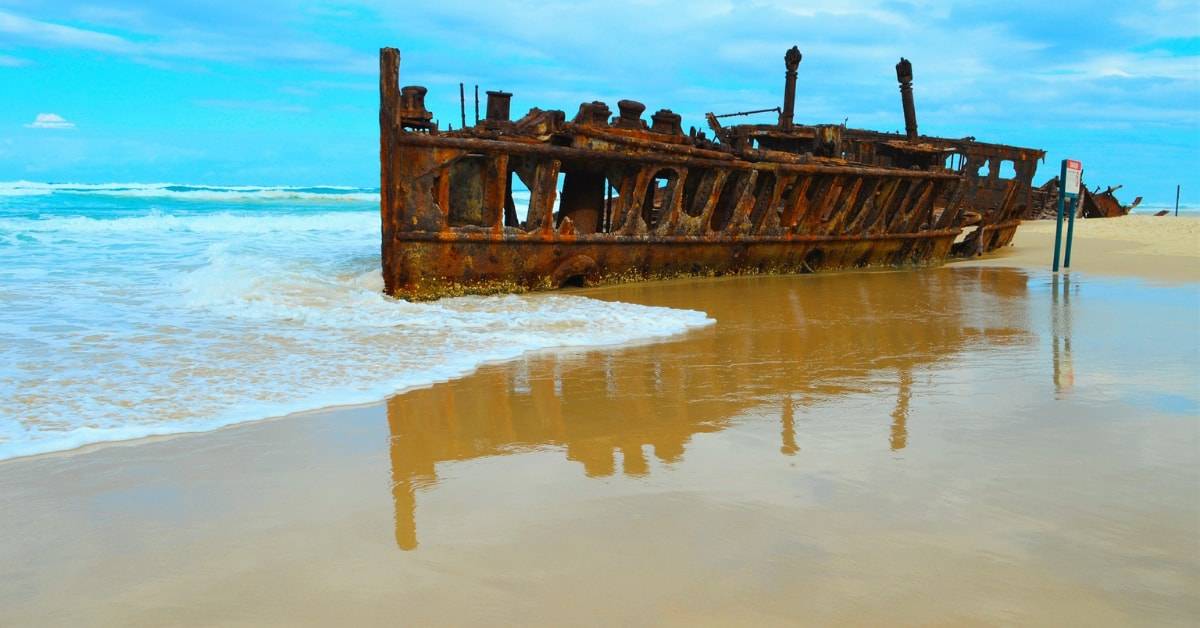
Holiday season is extremely busy for this camp valley area in large part due to its amenities, private campsites, fenced campsites including picnic tables, flush toilets, and dingo fences.
Close proximity to Fraser Island Retreat. Happy Valley is your go-between roughing it and civilized life. One of the best beach camping zones.
Happy Valley Available Facilities:
- Wheelchair access
- Tent camping beside car
- Walking
- Paid showers
- Picnic tables
- Scenic driving
- Flush toilets
- Dingo Fence
- Pay telephones
- Resort accommodations
- Camper trailers camping
Eli Creek Recreation Area
The smooth current of Eli Creek will help you relax after setting up camp. Bring a tube if you have one.
A World Heritage Site known for its amazing dune formations and natural landscapes.
Nearby Galuri accompanies this North East Coast camping area and boasts walks that’ll leave you wanting more.
The area has plenty to do for the whole family but tends to be lacking a few creature comforts such as flush toilets, picnic tables, and hot showers.
Eli Recreation Area Available Facilities:
- Generators allowed
- Tent camping beside car
- Walking
- Ocean fishing
- Scenic driving
- No Dingo Fence
- Camper trailers camping
Poyungan & Winnam Recreation Area
Both Poyungan & Winnam are suited to your next holiday.
Plenty of shade from the blistering sun and yet so close to open ocean fishing.
Nearby picnic tables, as well as 4x4 tracks, will keep the whole family entertained.
Poyungan & Winnam Recreation Area Available Facilities:
- Generators allowed
- Tent camping beside car
- Walking
- Ocean fishing
- Scenic driving
- No Dingo Fence
- Bring own toilet
- Camper trailers camping
Galuri Recreation Camping Area
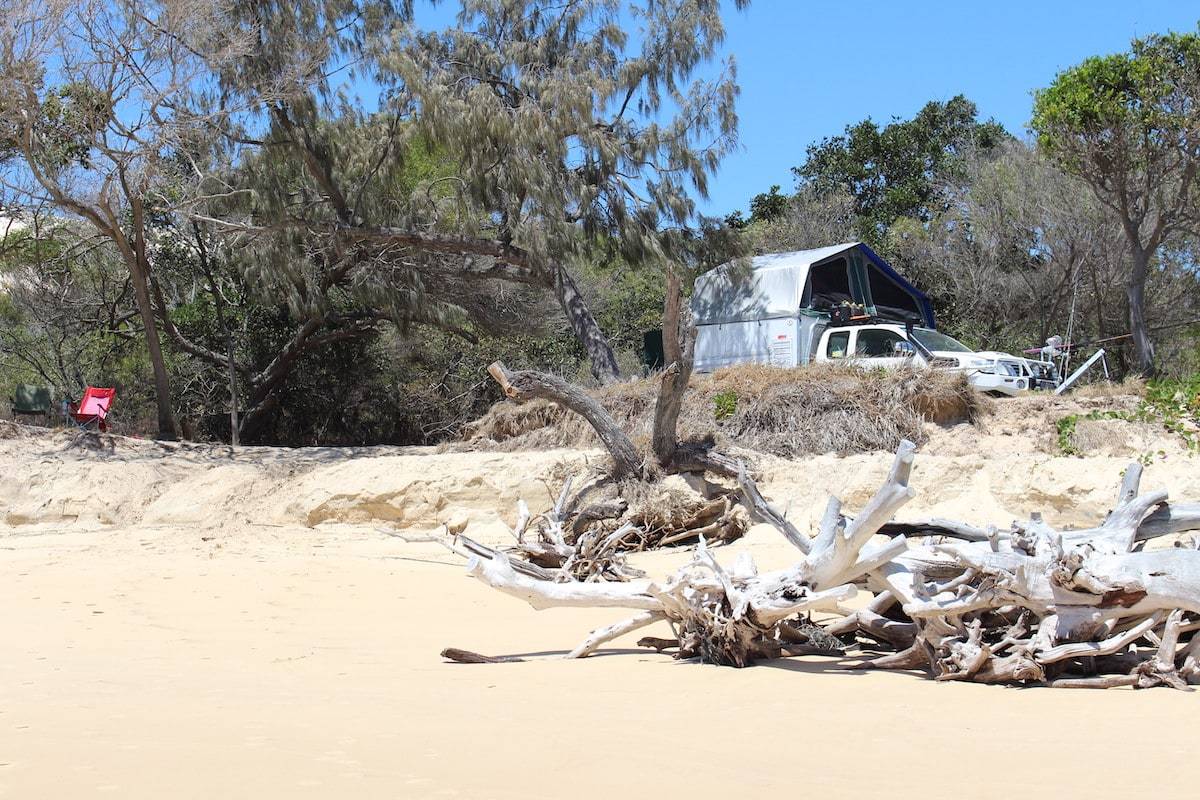
At the nearby Lake Garawongera walk you can take a swim before you return to camping on Fraser Island.
Recommended you stay a few days to take in all that this area has to offer. Plenty of freshwater lakes including nearby Lake Boomanjin.
Open 24hrs a day, just don’t forget to check in to your camping area after 2:00PM and book early to get a site near amenities such as picnic tables, fire rings and the peace and quiet.
Galuri Recreation Camping Area Available Facilities:
- Generators allowed
- Tent camping beside car
- Walking
- Ocean fishing
- Southern Lakes Scenic drive
- No Dingo Fence
- Camper trailers camping
Dilli Village Campsite
Lovely cottages, as well as tent camping along 75 Mile Beach, ensure plenty of options while camping on Fraser Island. Lake Boomanjin walk is nearby too!
Onsite facilities for everything you might need to escape and relax.
Booking in advance is recommended due to the popularity of this North East Coast site.
Dilli Village is the most northern tip of our list and is located 24km north of Hook Points.
Dilli Village Campsite Available Facilities:
- 25 tent campsites
- 5 bunkhouses
- 6 cabins
- Surfing
- Picnic Tables
- Kitchens available
- 200m walk to the beach
- Internet available
- Onsite Electricity
- 3 vehicle tracks
- Start of the great walk
- Dingo fence around the property
- Toilet block
Off-Road Driving Tips
Off-Roading on Fraser Island can be an experience for the novice driver. Sand can be a tricky surface to navigate so we’ve compiled a few tips for the trek to your campsite. The journey can be fun of course! But a mishap here can go from bad to really bad quickly if you are not prepared.
Do I need to have experience driving off-road? What’s the right vehicle for sandy beach driving? How hard is it to learn? And the ultimate question is, what do I do if I get stuck?
What Type of Vehicle?
Exploring Fraser island requires a High Clearance 4 Wheel Drive Vehicle with a Low Range feature and ideally clear tow points to attach D-Shackles to.
Ideally you would have at least two vehicles going in convoy so you can help each other if you get stuck, otherwise you’ll be relying on the kindness of strangers.
What Type of Camp Setup?
Although you can camp on Fraser island with a camper trailer, we find that in some situations on, a Camper Trailer can quickly become a liability. For example:
- If you are bogged in soft sand (which will inevitably happen at least once) it’s much easier to get out without a trailer, the last thing you want to do is rely on the generosity of others to pull your trailer out.
- Your vehicle has to work extra hard to get through soft sand cuttings and inland tracks (if high tide) towing an extra set of wheels, axles, suspension etc.
- In some situations due to your circumstances you may be forced to traverse rocky outcrops which aren’t roads due to high tide. These rocks are jagged & sharp with steep inclines & declines. You want to retain the maximum approach and departure angles, having a trailer can limit that.
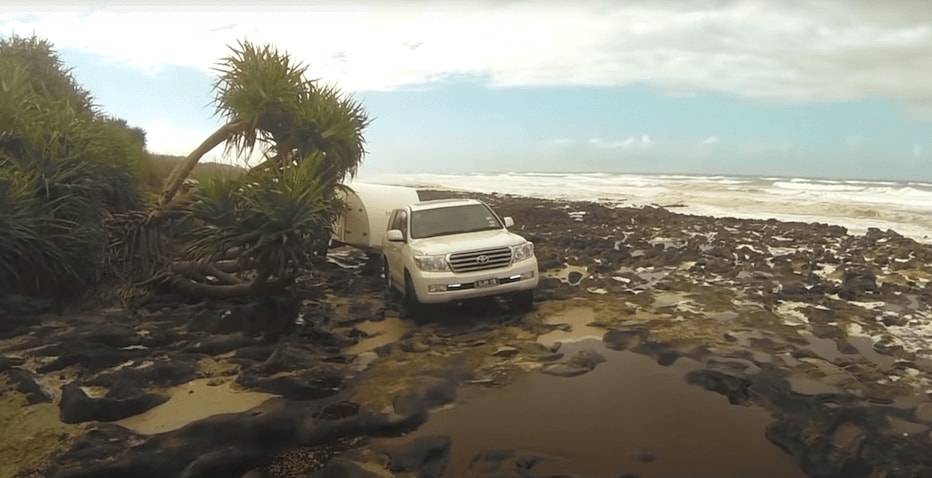
4. Some of the inland tracks are single lane but two way, so when another car (or massive tourist bus) is heading your way, one of you have to give way by pulling off into very small sandy areas in the middle of the thick rainforest. When you have a longer vehicle, it’s sometimes hard to make enough space for the other vehicle to get past. And can result in quite an awkward situation, holding up traffic, getting stuck etc.
So using a Vehicle only camp setup would be preferable for you to stay lightweight & nimble no matter what obstacles the island throws at you.
We love using our Trayon Slide on Camper for accessing the more remote areas of the island, it still has all the amenities a camper trailer or caravan has, just in a more compact, lightweight formfactor.
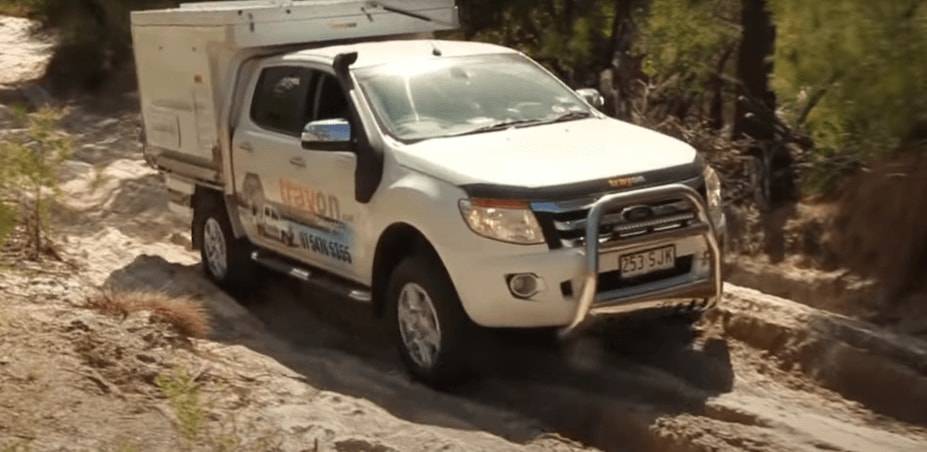
Tyre Pressure makes a difference
Before driving into the sandy beyond for your beach camping adventure, lower (deflate) your tyre pressure to half the recommended pressure rating. You can find this measurement on the sidewall of your tyres.
A good rule of thumb is approximately 20psi. This spreads the footprint of the tyres and adds traction.
Just remember to inflate your tyres once you’re back on the road.
Bring Recovery Gear for When you Get Stuck.
It’s merely a matter of time before you get in deeper than your rig can handle. Off-roading is supposed to be fun and this is part of it.
If you used our vehicle packing list then you should have everything you need to get out of any jam.
On Fraser Island people are usually quite generous and help if you get stuck, but it’s not a guarantee. So if you have a second 4WD in your convoy, you can easily snap strap your way out, for tougher situations you can also use the traction boards & shovels.
Follow until you can lead
Watching other drivers can be your first indication as to what's over the next obstacle. Having a spotter is ideal and no matter what your passenger says, that's their job.
If you don’t have a spotter then watch the other campers on Fraser Island. A lot of experienced drivers visit the island so you are sure to be a pro in no time.
Just be patient and follow until you can lead.
The Right Time To Drive: Avoid High Tide & Night Driving
High tide comes and goes but most of all it restricts movement on Fraser Island. Driving on the beach during high tide is extremely dangerous and should be avoided at all times. Driving at night is also extremely dangerous, especially at high tide. Sometimes night driving can’t be avoided, but plan ahead and try to get to camp before high tide and / or night time (whichever comes first).

Two hours before and after high tide is the golden rule for the safest travel times on the island. The tide is somewhat predictable but always watch the water because it can still linger. If the tide is blocking your path, wait! Do not cross-ocean swell areas.
Remember that there are inland tracks as well when the tide is high.
Salt Water & Vehicles
Saltwater can damage your vehicle, and could potentially void any warranty you have. It can accelerate rust growth, and it’s not pretty so we advise a thorough underbody rinse after your holiday on the Island.
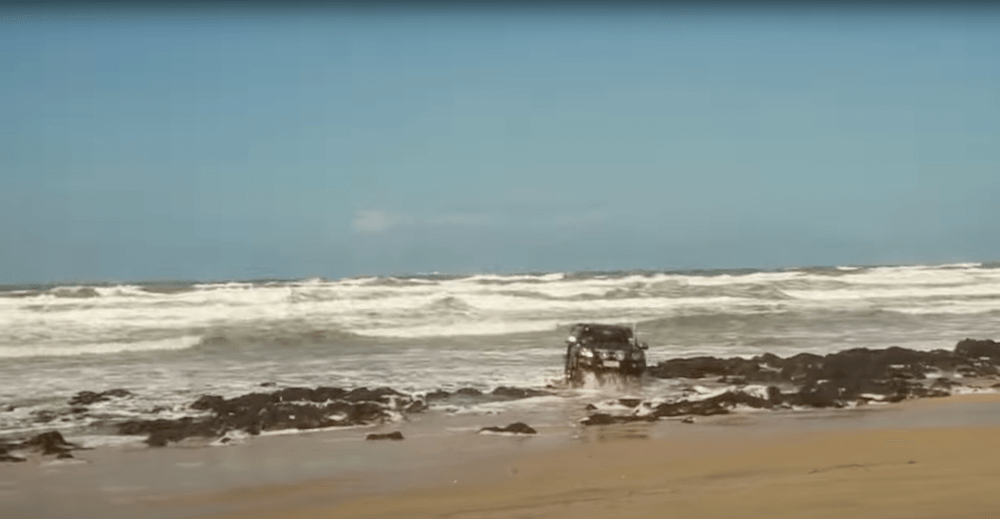
Be sure to pack some patience
Speed limits are posted on Fraser Island but island life is supposed to be more relaxed, embrace it.
75 Mile Beach is posted at 80kph and several zones are 40kph but you don’t have to ride the limit. Hang back and enjoy the ride, be very curties of other drivers and pedestrians, they are trying to relax.
Push the speed limit and patrolling police will definitely get involved. The thrill is not worth the ride and returning home safely is key.
Rainy days Are Your Friend
If the rains come before or during your trip stand tall and have no fear it’s a good thing.
Rain compacts the sand and adds traction and easy access to the tracks traversing Fraser Island.
Beach Driving Techniques
Stay on the hard sand (but not wet sand) as much as possible. But when you have to venture into the soft areas here are two tips:
- Keep to other peoples tracks (the sand will be more compacted)
- Consistent throttle is key to maintain momentum
Having a consistent throttle keeps you from sinking into the mush. Spinning wheels is normal in dry conditions but when your tyres increase rotation speed too much or lose rotation speed you will sink into the sand.
Ride in a smooth consistent throttle and follow other people's wheel tracks and you’ll minimize getting bogged in the soft sand.
Slow right down when crossing freshwater streams going into the ocean, otherwise you may regret it! Also, it goes without saying slow down around pedestrians or other parked vehicles.
One last tip about beach driving. There are no lanes, yet beaches have two way traffic on high tide and low tide!
As you approach a 4WD coming the opposite direction, use your indicator to show them which side you’ll be passing them on. Typically it will be to the left.
Find Detours if in Doubt
Most tracks on Fraser Island have alternate routes if you should feel uneasy about a particular section. Talk to the locals and ask if there is anything you should be aware of before you attempt a section you are unfamiliar with.
Driving on Fraser Island’s sand is easier with just a few simple adjustments to your driving technique.
Conclusion
You’re all set! You’ve received your permits, booked the ferry, prepped your vehicle, packed all the essentials, and stocked the food storage for the epic beach camping ahead.
It’s finally time to start your holiday and we hope this comprehensive guide to camping on Fraser Island has helped.
Review the provided checklists so you don’t forget anything and remember it’s ok if you do. The island shops will hook you up with the basics, so you’ll enjoy your holiday stress-free.
If you have any last questions, check out the Parks K'gari (Fraser Island) - Frequently Asked Questions page.
We believe having a Trayon Camper is a valuable asset for camping at K’gari because:
- you have smaller barge fees than a Camper Trailer, yet still have the comfort,
- it’s easier and less strain on your vehicle to get through soft sand to the Good Campsites,
- Getting out of a boggy situations is much simpler.
- You can free stand the camper and still use your vehicle to go explore
- No additional registration
- Only a 5-10 min setup
- Less impact on the environment due to lighter weight rig and less tire spinning
Now get to the ferry and let the adventure begin!
P.S. If you are looking for more places to camp near by, check out our QLD touring & camping guides.
